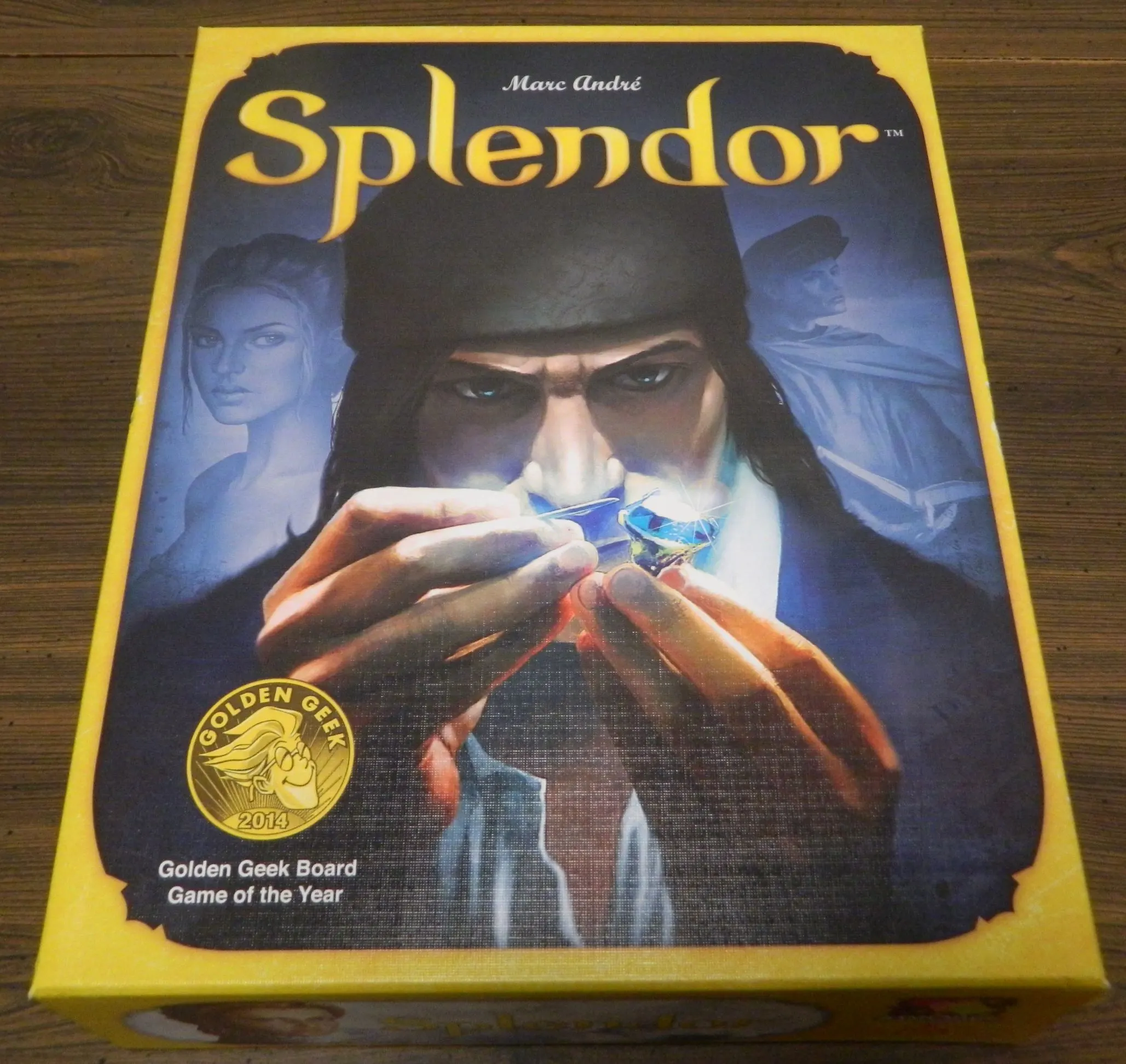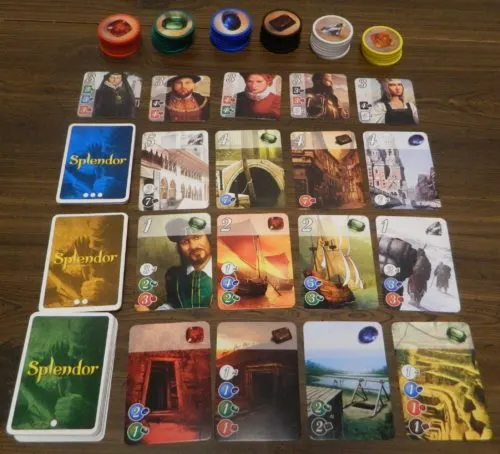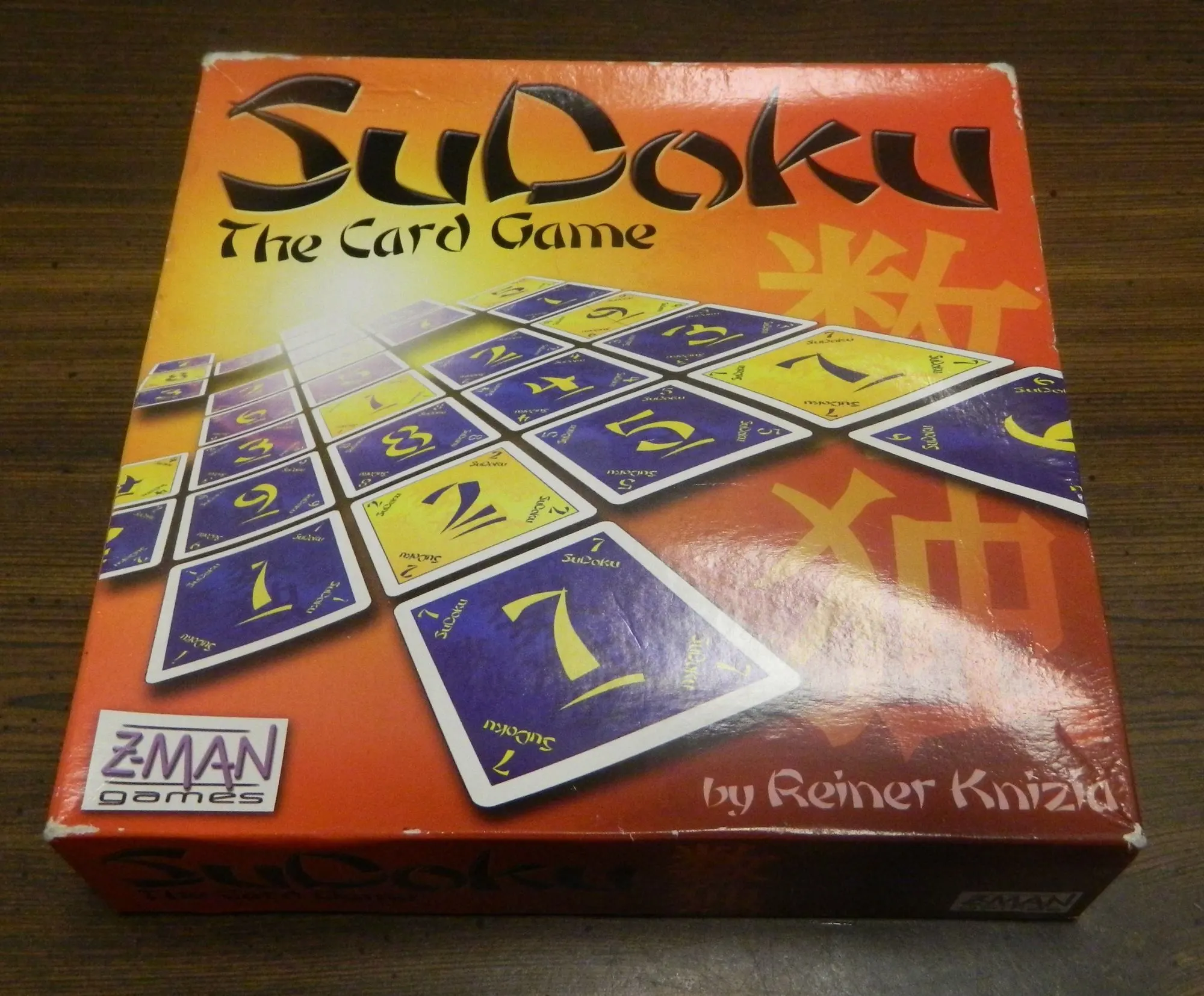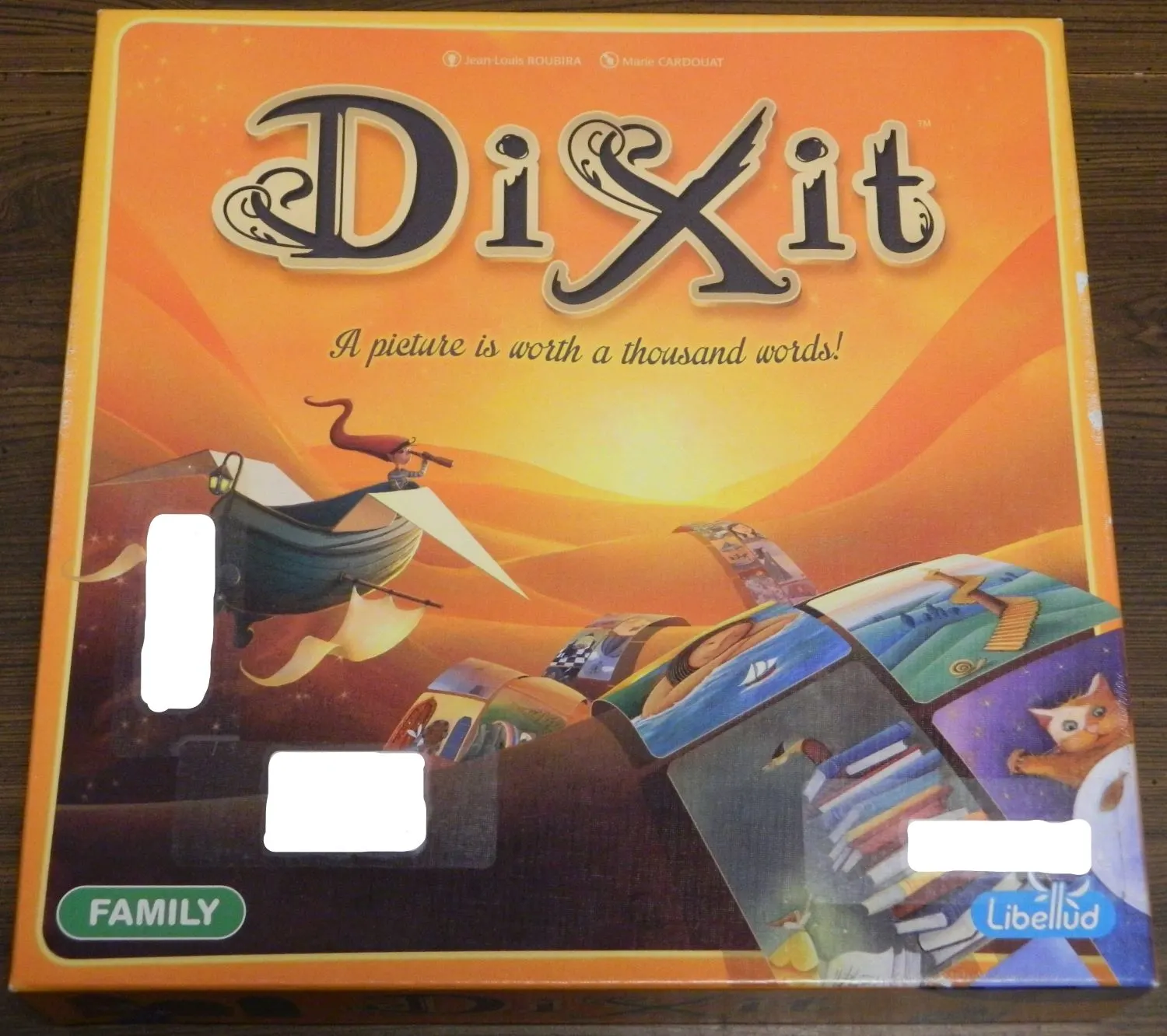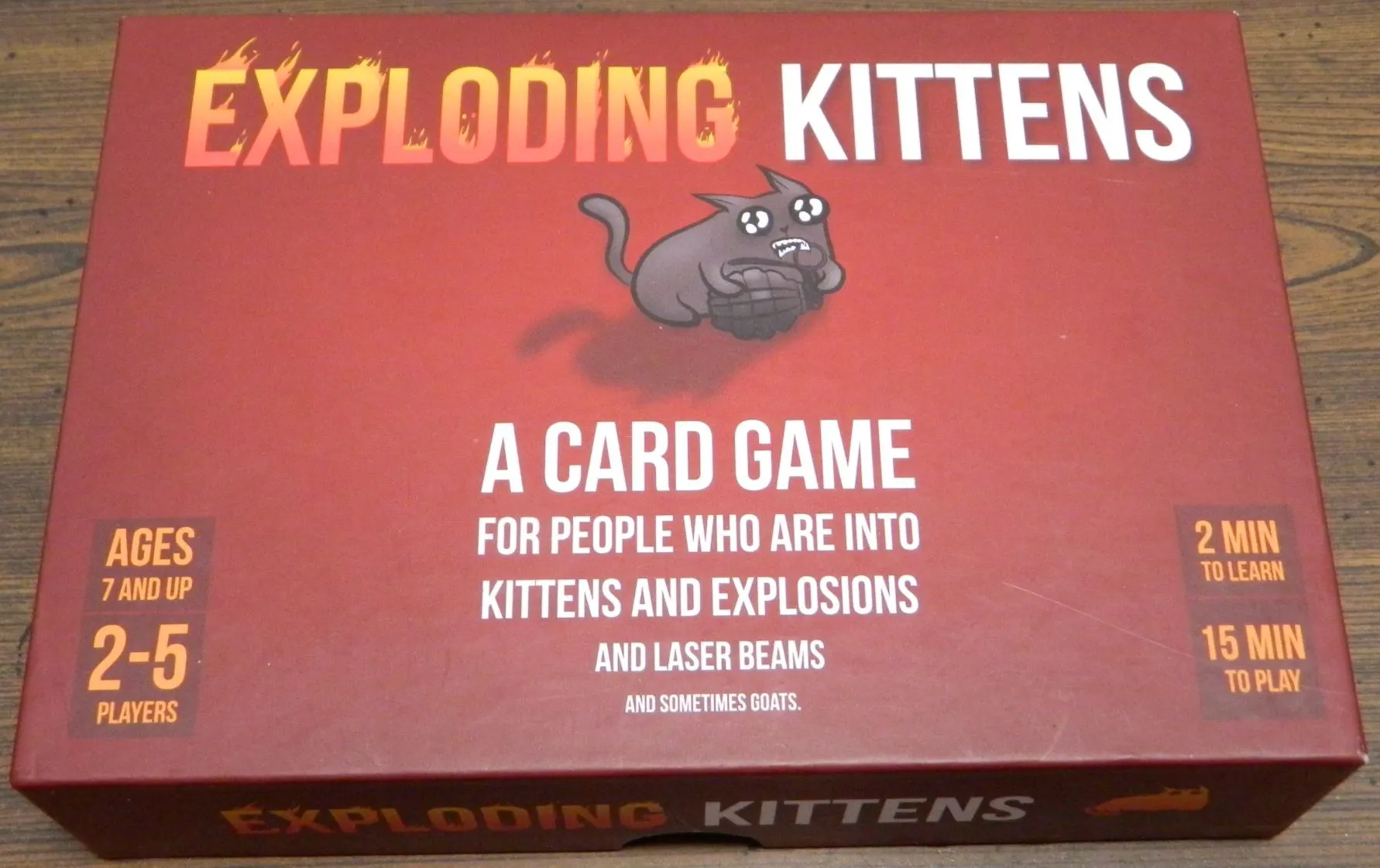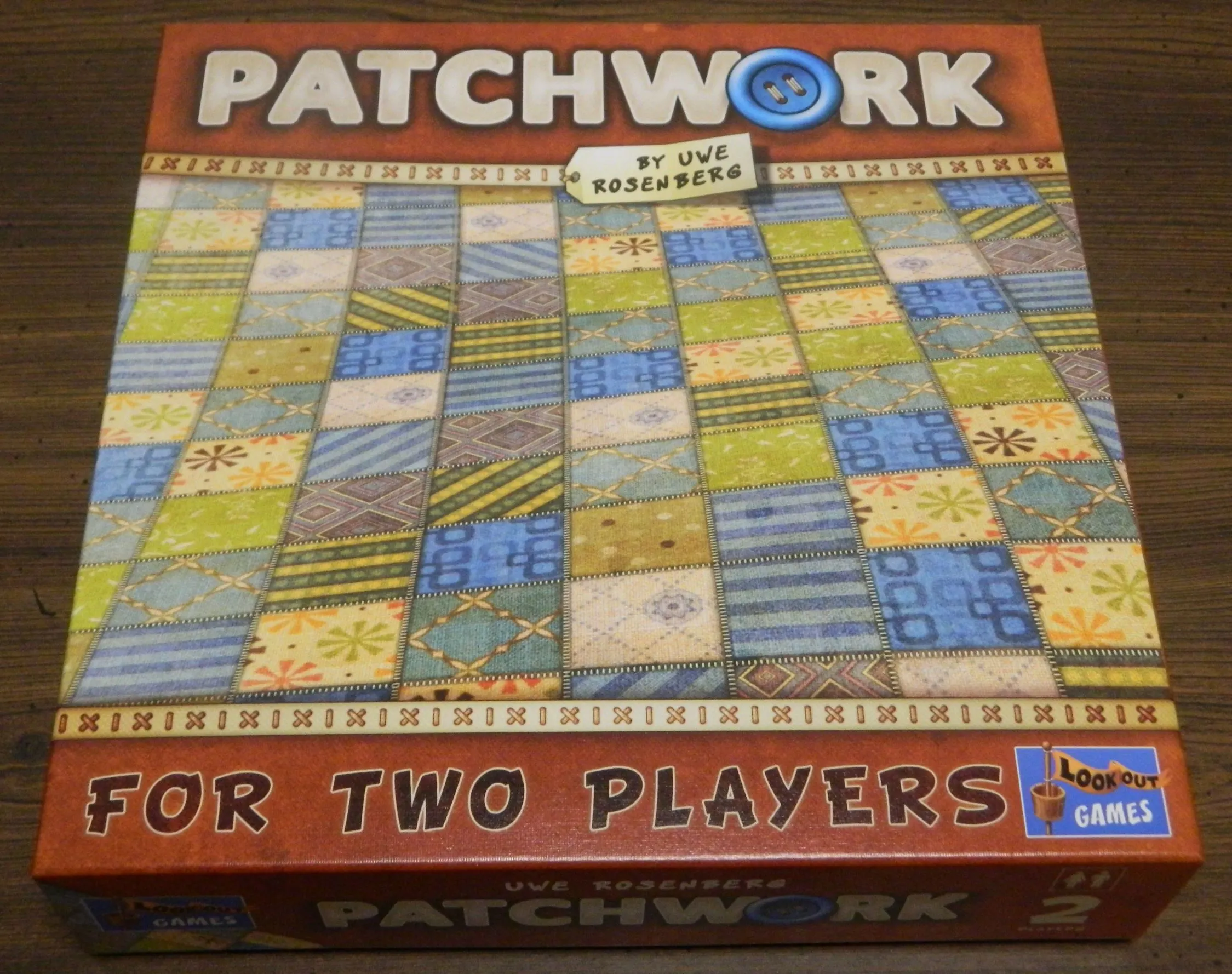Released in 2014 Splendor quickly made a name for itself. It became a finalist for the Spiel Des Jahres in 2014 ultimately losing to Camel Up. It also currently sits close to being one of the top 100 board games of all time on Board Game Geek. While the game’s hype didn’t hurt, Splendor’s premise is intriguing enough that I would have been interested in trying it out even if it didn’t have great ratings. Splendor combines some of my favorite board game genres including set collecting and card drafting into a game where you are building an “engine” which will help you acquire better cards on future turns. While I haven’t reviewed a lot of “engine-building” games in the past, I have always enjoyed the genre as it is so satisfying building up something that you can expand to greater things. Splendor does a fantastic job combining different mechanics together to create a truly compelling game that anyone can enjoy.
How to Play Splendor
Setup
- Sort the development cards based on the back of the cards. Shuffle each of the three decks separately. Place the decks so the o deck is on the bottom followed by the oo and the ooo decks.
- Take the top four cards from each development pile and place them face up to the right of the draw pile.
- Shuffle the noble tiles and reveal as many of them as the number of players plus one. These tiles are placed above the development cards. The rest of the noble tiles are returned to the box.
- Place the tokens on the table in six piles based on their color.
- The youngest player starts the game.
Playing the Game
On a player’s turn they will take one of four actions:
- Take One Gem of Three Different Colors
- Take Two Gems of the Same Color
- Reserve A Development Card
- Purchase A Development Card
Taking Gems
If a player would like to take gem tokens they have two options. With these options they can take any color tokens except for the gold tokens.
First they may take one gem token from three different colors.
Otherwise the player may choose two gem tokens of the same color. In order to take two gem tokens from the same color there needs to be at least four tokens of that color available.

This player has chosen to take tokens. They can either choose to take one token in three different colors or they can choose to take two red, black or white tokens. They can’t take two green or blue tokens because there are less than four of those color tokens available.
If a player ever has more than ten tokens at the end of their turn, they must return tokens to the supply until they only have ten tokens left.
Reserving A Development Card
If a player fears that another player may take a development card that they would like, they can use their turn to reserve a card. To reserve a card the player will take the card they want and add it to their hand. The card that was taken is replaced by a card from the same deck. A player may never have more than three development cards in their hand at any time. You may never discard a development card from your hand as the only way to get them out of your hand is to purchase them on a future turn.
For reserving a development card the player will get to take a gold token. Gold tokens are wild as they can act as a token of any other color.
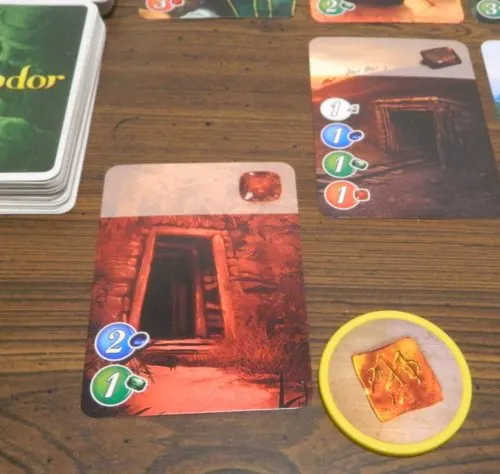
This player has decided to reserve this card. They will add the card to their hand and take a yellow token.
Buying A Development Card
If a player would like to purchase a development card they can either buy one of the development cards on the table or one of the cards in their hand.
To purchase a development card you must spend the tokens or use gem bonuses (see Development Card section below) equal to the gems shown in the bottom left corner of the card. A gold token may replace one of the tokens required to purchase the card. Any tokens that are spent are returned to the bank.
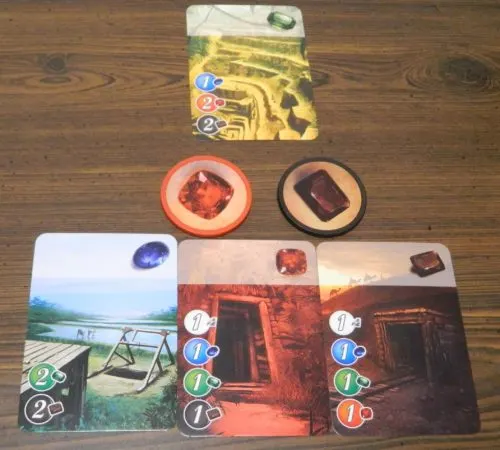
In order to purchase the card at the top of the picture the player needs one blue, two reds, and two blacks. They will need to use one red and one black token. The other required gems come from cards the player has acquired from the development cards at the bottom.
Once a player has purchased a development card they will place it face up in front of them. The development cards should be sorted into piles based on the gem in the top right corner. The cards should be displayed so all of the gems are visible.
Development Cards
Each development card has three pieces of information that are relevant to the game.
The number in the top left corner is the number of prestige points that the card is worth. These prestige points are used to win the game.
The gem in the top right corner is the gem bonus that this card provides. When you purchase a development card this bonus will count as the associated gem for the rest of the game. It can be used when purchasing other development cards and the card will never be discarded.
Finally the number and gems in the bottom left corner indicate the cost to purchase the development card. In order to purchase a card you must pay tokens or have gem bonuses equal to all of the gems shown.
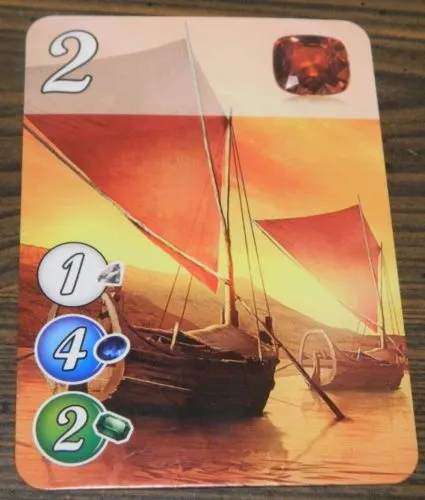
This development card is worth two prestige points (top left corner). When acquired the card will provide one red gem for the rest of the game (top right corner). To purchase the card you will need one white, four blue, and two green gems.
End of Turn
After a player has taken an action on their turn, they will check to see if they have the development cards required to take one of the available noble tiles. To take a noble tile players need to have development cards that match the requirements shown on the noble tile. If a player meets the requirements for more than one of the noble tiles, they will choose which tile they prefer as they can only take one each turn. The noble tile that a player takes will be placed face up in front of them and will count as three prestige points.
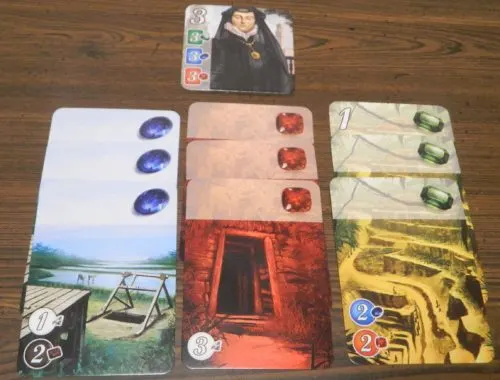
To acquire this noble tile a player needs to acquire three green, three blue, and three red gems. As this player has acquired these gems they will get to take the noble tile.
Play will then pass to the next player clockwise.
End of Game
When one of the players reach 15 prestige points between their development cards and noble tiles, the game will enter its final round. Each player who hasn’t had a turn yet this round will get to take one more turn so all of the players have had the same number of turns.
Players will then count up how many prestige points they have acquired. The player who acquired the most prestige points will win the game. If there is a tie the tied player with the least development cards will win the game.
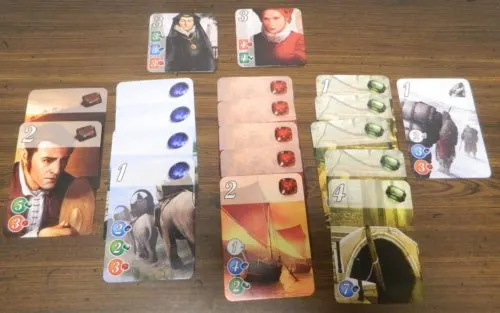
This player has scored 17 points. They have scored six points from the noble tiles and eleven points from the development cards they acquired during the game.
My Thoughts on Splendor
Heading into Splendor I had really high expectations between the game being a runner up for the Spiel Des Jahres and how highly the game is rated on Board Game Geek. I would say that for the most part Splendor didn’t disappoint.
I think the reason that Splendor succeeds is that it finds the perfect balance between accessibility and strategy. I have to say that I was genuinely surprised by how easy it was to play Splendor. The game is surprisingly easy to play because the mechanics are quite straightforward. The goal is to acquire prestige points. To do this you first need to acquire gem tokens which you can then use to acquire development cards. These development cards give you prestige points and help you get more powerful development cards by acting as gem tokens when purchasing new cards. None of the mechanics in the game are very hard which makes the game easy to teach as it shouldn’t take more than five or so minutes to teach the game to new players. New players might not understand the strategy right away, but they should have no trouble picking up the gameplay. This simplicity means that the game should appeal to people that don’t like more complicated games as well as children. Splendor has a recommended age of 10+ but I think children a little younger than that shouldn’t really have any troubles playing the game.
What makes Splendor shine though is that it packs so much into such a simple game. The game has some reliance on luck (more on this later) but strategy is the driving force behind the game. Without a good strategy you aren’t going to win Splendor. Basically the goal of Splendor is to build an engine that will help you acquire better cards later in the game. Each game starts the same as you begin with nothing. For your first couple of turns you will acquire tokens which you will then use to acquire development cards. These development cards are then used to acquire more cards. You repeat this over and over again until you have created an engine strong enough where it is pretty easy to acquire even the best cards in the game.
There is something that I have always liked about games where you start with nothing and you slowly start building up to a more powerful position. It will take you a couple turns to acquire your first couple of cards. If you acquire the right cards though you can turn them into many more cards pretty quickly. It is just so satisfying building an efficient machine as you see it grow more and more powerful. This feels like you are accomplishing something as you can see how your previous decisions impact future decisions. Fans of deck builders and these type of engine building games should really enjoy Splendor.
In addition to it being satisfying seeing your power continue to grow, I think Splendor works because it gives you some interesting decisions to make each turn. This is due to some clever mechanics that force you to choose between being aggressive or more passive.
Lets begin with taking tokens. The game gives you two different ways to acquire tokens in the game. You can either acquire two tokens of the same color (as long as the other requirement is met) or you can take one token of three different colors. This is an interesting decision for a couple reasons. Most of the cards in the game require having multiple tokens of the same color. Thus taking two tokens of the same color may get you closer to purchasing a card that you want. Taking one token of three colors ends up giving you more tokens though. Therefore you are sacrificing a token in order to get two tokens of a color you need. Ultimately if you can find a way to plan ahead to know what tokens you need you are better off taking three different colors as you ultimately will end up with more tokens allowing you to purchase more cards. In some situations though you are going to want to take the two tokens as they will be the tokens you need to purchase a card.
I think the most interesting mechanic is the ability to reserve cards. You don’t see a lot of games that let you reserve cards that you can then purchase on a future turn. When you think about it though it actually brings quite a bit to the game. By reserving a card you guarantee that you will get to eventually buy the card. You will also get a wild token that can be used to later purchase the card or be used to purchase another card. Choosing this action requires you to spend two turns to buy the card though. Turns are important in the game and you don’t want to waste them. This creates an interesting dilemma where you debate whether to purchase the card or wait and hope to be able to purchase the card on a future turn. Avoiding reserving cards will save you turns but you never know if another player will either purchase or reserve it before you can purchase it. You could monitor which players have enough tokens to purchase the card, but they could just as easily reserve the card themselves throwing a wrench into your plans.
While all of the players in the game will use their first couple of turns to acquire a couple of development cards, players’ strategies will then begin to diverge. After the start there are two basic approaches to the game. One strategy is to spend quite a bit of time building up your resource pool with the lowest level of cards. Even if a lot of these cards don’t give you prestige points, they will give you resources that you can use later in the game. As these cards are easier to acquire they allow you to quickly build up a resource pool. Otherwise you could start acquiring higher level cards early in the game to get you closer to the number of points needed to win the game. You won’t have as many resources available to you but you could acquire the necessary points before the other players can catch up. Ultimately players need to balance between these two extremes as you can’t focus too much on either. If you spend all your time acquiring resources another player can sneak in and get enough points to win the game before you can start to use your resources. If you don’t spend enough time building up your resources though you will start to stall as it will be hard to acquire the higher level cards.
All of this leads to Splendor being a really enjoyable experience. The gameplay is really satisfying and fun. Splendor is simple enough that it won’t overwhelm people and yet it still has enough strategy to keep players interested. Splendor might not appeal to people that only like really strategic games, but it should work really well for most other people. I think the game could do a really good job as a gateway game as it should appeal to both people that only casually play games as well as people that play a lot of board games. Splendor also plays quite quickly for the type of game that it is. With most games taking only 30 minutes you could easily play games back to back. With how fun Splendor is to play I could definitely see players wanting a rematch.
Splendor’s component quality is also quite good. I will admit that Splendor’s theme is not great. Basically Splendor’s theme involves you being a rich merchant during the Renaissance. Thus you acquire resources and other items that will help you create beautiful gems. The theme for the most part feels pasted on as it doesn’t really impact the gameplay. Other than the lack of a theme though the components are quite good. I really liked the game’s artwork. I also appreciate games that utilize symbols instead of relying on a lot of text as the game is language independent. The cards, tiles and tokens have some weight to them as well where they feel like they are of a good quality.
While Splendor is a great game it does have some issues regarding luck. Splendor has quite a bit of strategy, but it also relies on quite a bit of luck as well. Having luck is not going to make up for a terrible strategy, but if it is combined with a good strategy you are going to have a very good chance of winning the game. The luck in Splendor mainly comes from two different sources.
The most important source for luck is what development cards get flipped over when a player purchases or reserves a development card. You could either have a card come up that you don’t really care about or a card that is perfect for your current strategy. If a player regularly has cards turned over that they really want, they are going to have a significant advantage in the game. If they are the first player to get a crack at the new card they can either purchase or reserve it before another player even has the option of taking it. Meanwhile other players may keep getting cards revealed that they can’t purchase or don’t really want. The difference between players getting the cards they want or don’t want can have a pretty big impact on the game.
This reliance on luck also comes into play with regards to the noble tiles. The noble tiles are quite important in the game as they are a good source of prestige points. They are first come first served though as only one player can claim them. If the requirements for the noble tiles are well distributed between all of the colors, this isn’t a big problem as players can pursue different colors and thus the noble tiles should be pretty well split between all of the players. As the noble tiles are randomly chosen though it means that you could get several noble tiles that basically require the same colors. Thus one player can get most of the development cards of those colors and take several of the noble tiles. Depending on the luck of which development cards are revealed one player may have a huge advantage by claiming multiple noble tiles and easily winning the game.
As a sort of side note to the reliance on luck, Splendor is also one of those games that you are going to have a hard time catching up in if you fall behind early. As the whole goal of Splendor is to build an engine that allows you to purchase better cards on future turns, if you fall behind on acquiring cards early in the game it will impact you for the rest of the game. This is due to each card you acquire being able to be used to acquire more cards. If you fall behind the other players in cards early in the game they will likely continue to grow their lead.
To illustrate how things can snowball quickly as well as the reliance on luck I want to quickly tell you what happened to me in one game we played. The beginning of the game was pretty normal as players took actions in order to acquire their first couple of development cards. After I acquired my first couple of development cards though things took off and never slowed down. It began with me being able to buy my first tier one development card for “free” as I just needed the bonuses on my development cards to purchase the new card. Then on the next turn I once again got a card that I could purchase for free. These free cards expanded my resource pool which made it possible to purchase additional cards. At this point I rarely ever had to use tokens to purchase cards. I just kept acquiring more development cards on almost every turn. Outside of reserving a couple cards I didn’t have to take a single token after the first couple of rounds. All of these free cards lead to me gaining a significant lead on the other players. I ended up winning the game with close to twice as many points as the player in second place.
Should You Buy Splendor?
Heading into playing Splendor I had high expectations due to the acclaim that it has received. For the most part I wasn’t disappointed either. Splendor succeeds because it does a great job balancing between accessibility and strategy. The game is surprisingly easier to play than I was expecting. The game has quite a bit of strategy as well though. The game gives you enough decisions to make where you can craft your own strategy. What is so satisfying about the gameplay though is that throughout the game you are building a more powerful machine. At the beginning of the game it will take you a couple turns just to acquire one low level card. Each card you acquire though makes it easier to acquire more cards. It is just so satisfying seeing your power grow throughout the game. The only problems that I had with the game is that it relies a little too much on luck and if you get off to a bad start you are going to have a hard time winning the game.
I really enjoyed my time with Splendor. If you don’t really like these type of games, Splendor may not be for you. If the game sounds at all interesting to you though I think you will really enjoy it. I would highly recommend picking up Splendor.
If you would like to purchase Splendor you can find it online: Amazon, eBay

